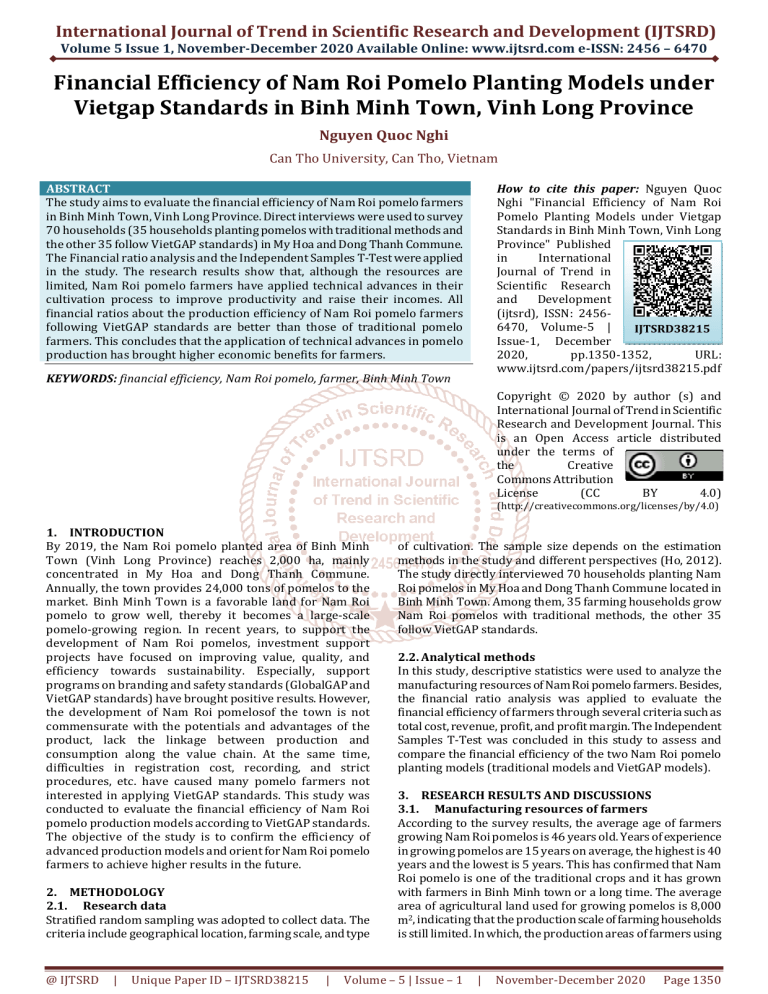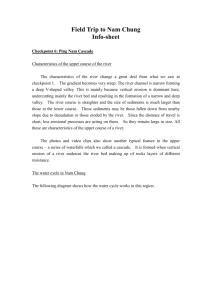
International Journal of Trend in Scientific Research and Development (IJTSRD)
Volume 5 Issue 1, November-December 2020 Available Online: www.ijtsrd.com e-ISSN: 2456 – 6470
Financial Efficiency of Nam Roi Pomelo Planting Models under
Vietgap Standards in Binh Minh Town, Vinh Long Province
Nguyen Quoc Nghi
Can Tho University, Can Tho, Vietnam
ABSTRACT
The study aims to evaluate the financial efficiency of Nam Roi pomelo farmers
in Binh Minh Town, Vinh Long Province. Direct interviews were used to survey
70 households (35 households planting pomelos with traditional methods and
the other 35 follow VietGAP standards) in My Hoa and Dong Thanh Commune.
The Financial ratio analysis and the Independent Samples T-Test were applied
in the study. The research results show that, although the resources are
limited, Nam Roi pomelo farmers have applied technical advances in their
cultivation process to improve productivity and raise their incomes. All
financial ratios about the production efficiency of Nam Roi pomelo farmers
following VietGAP standards are better than those of traditional pomelo
farmers. This concludes that the application of technical advances in pomelo
production has brought higher economic benefits for farmers.
How to cite this paper: Nguyen Quoc
Nghi "Financial Efficiency of Nam Roi
Pomelo Planting Models under Vietgap
Standards in Binh Minh Town, Vinh Long
Province" Published
in
International
Journal of Trend in
Scientific Research
and
Development
(ijtsrd), ISSN: 24566470, Volume-5 |
IJTSRD38215
Issue-1, December
2020,
pp.1350-1352,
URL:
www.ijtsrd.com/papers/ijtsrd38215.pdf
KEYWORDS: financial efficiency, Nam Roi pomelo, farmer, Binh Minh Town
Copyright © 2020 by author (s) and
International Journal of Trend in Scientific
Research and Development Journal. This
is an Open Access article distributed
under the terms of
the
Creative
Commons Attribution
License
(CC
BY
4.0)
(http://creativecommons.org/licenses/by/4.0)
1. INTRODUCTION
By 2019, the Nam Roi pomelo planted area of Binh Minh
Town (Vinh Long Province) reaches 2,000 ha, mainly
concentrated in My Hoa and Dong Thanh Commune.
Annually, the town provides 24,000 tons of pomelos to the
market. Binh Minh Town is a favorable land for Nam Roi
pomelo to grow well, thereby it becomes a large-scale
pomelo-growing region. In recent years, to support the
development of Nam Roi pomelos, investment support
projects have focused on improving value, quality, and
efficiency towards sustainability. Especially, support
programs on branding and safety standards (GlobalGAP and
VietGAP standards) have brought positive results. However,
the development of Nam Roi pomelosof the town is not
commensurate with the potentials and advantages of the
product, lack the linkage between production and
consumption along the value chain. At the same time,
difficulties in registration cost, recording, and strict
procedures, etc. have caused many pomelo farmers not
interested in applying VietGAP standards. This study was
conducted to evaluate the financial efficiency of Nam Roi
pomelo production models according to VietGAP standards.
The objective of the study is to confirm the efficiency of
advanced production models and orient for Nam Roi pomelo
farmers to achieve higher results in the future.
2. METHODOLOGY
2.1. Research data
Stratified random sampling was adopted to collect data. The
criteria include geographical location, farming scale, and type
@ IJTSRD
|
Unique Paper ID – IJTSRD38215
|
of cultivation. The sample size depends on the estimation
methods in the study and different perspectives (Ho, 2012).
The study directly interviewed 70 households planting Nam
Roi pomelos in My Hoa and Dong Thanh Commune located in
Binh Minh Town. Among them, 35 farming households grow
Nam Roi pomelos with traditional methods, the other 35
follow VietGAP standards.
2.2. Analytical methods
In this study, descriptive statistics were used to analyze the
manufacturing resources of Nam Roi pomelo farmers. Besides,
the financial ratio analysis was applied to evaluate the
financial efficiency of farmers through several criteria such as
total cost, revenue, profit, and profit margin. The Independent
Samples T-Test was concluded in this study to assess and
compare the financial efficiency of the two Nam Roi pomelo
planting models (traditional models and VietGAP models).
3. RESEARCH RESULTS AND DISCUSSIONS
3.1. Manufacturing resources of farmers
According to the survey results, the average age of farmers
growing Nam Roi pomelos is 46 years old. Years of experience
in growing pomelos are 15 years on average, the highest is 40
years and the lowest is 5 years. This has confirmed that Nam
Roi pomelo is one of the traditional crops and it has grown
with farmers in Binh Minh town or a long time. The average
area of agricultural land used for growing pomelos is 8,000
m2, indicating that the production scale of farming households
is still limited. In which, the production areas of farmers using
Volume – 5 | Issue – 1
|
November-December 2020
Page 1350
International Journal of Trend in Scientific Research and Development (IJTSRD) @ www.ijtsrd.com eISSN: 2456-6470
VietGAP models are twice more than those of traditional
models. The number of employees directly involved in pomelo
production accounts for about 50% of the household
population. In particular, the number of employees directly
plantpomelos under VietGAP standards is higher than those
who follow traditional methods. The education level of
pomelo farmers is quite low with the average grade is 7, there
are still illiterate farmers. However, farmers who plant
pomelosunder VietGAP standards have higher education
levels than those who grow pomelos using traditional
methods.
3.2.
Differences in production cost between two Nam
Roi pomelo planting models
Differences in manufacturing methods are the reason for
different cost structures of Nam Roi pomelo production
between traditional households and VietGAP producers.
Table 1: Comparison of production costs between the two models
Cost structure Traditional model VietGAP model Difference Significance level
Fertilizer cost
6,728,255
5,434,580
1,293,675
***
Pesticide cost
322,054
140,705
181,349
***
Fuel cost
744,122
823,544
-79,422
**
Labor cost
5,825,245
5,415,682
409,563
**
Depreciated cost
628,680
566,484
62,196
Ns
Other
850,548
822,560
27,988
Ns
Total cost
15,098,904
13,203,555
1,895,349
***
Note: ***: Significant at 1%; **: significant at 5%; ns: not significant.
Base on Table 1, there are differences in fertilizer cost, pesticide cost, labor cost, and fuel cost between farmers who follow
traditional farming and VietGAP standards. These are expenses that account for large proportions in the production process. If
fertilizer and pesticide are used appropriately, it helps save money and bring higher production efficiency. The field survey
showed that farmers applying VietGAP models reduce a significant amount of fertilizer for the planting areas of pomelos by
strict procedures of VietGAP to minimize the amount of chemical that exists in pomelos; as well as to meet purchasers’
requirements and technical requirements of export activities. In addition to this, farmers following VietGAP standards have to
apply the integrated pest management on planting areas and meet several food hygiene and safety requirements, which limits
the use of agro-pharmaceuticals. Therefore, farmers applying VietGAP standards save about 1,293,675 VND/1,000m2 of
fertilizer cost and 181,349 VND/1,000m2 of pesticide cost. In contrast, traditional farming households use fertilizers and
pesticides habitually. Although pests and diseases have not caused great impacts, farmers have intervened with chemicals in
high doses. Also, there is a difference in fuel costs in the two production models. Fuel costs in VietGAP-applying households are
higher than traditional farming households (an amount of 79,422 VND/1,000m2). The fuel cost mainly includes the cost of
using petrol and electricity to operate irrigation and spraying tools. VietGAP producers have to water the trees by their growth
process and focus on caring and irrigation, so the cost used is higher than traditional farming households.
3.3. Compare the economic efficiency between two Nam Roi pomelo planting models
According to the testing result, all financial ratios showing the production efficiency of VietGAP farmers are better than those of
traditional farmers. This points out that the application of technical advances in pomelo production has brought higher
economic benefits for farmers. Specifically, the total cost of Nam Roi pomelo farmers under VietGAP models is lower than that
of traditional farmers, while the productivity, price, and revenue of VietGAP farmers are all higher than farmers by traditional
methods. As a result, the proportion of profit/cost, profit/revenue, and revenue/cost of VietGAP farmers are much higher than
those of traditional pomelo farmers.
Table 2: Comparison of economic efficiency between two Nam Roi pomelo planting models
Financial ratios
Traditional model VietGAP model Difference Significant level
Total cost
15,098,904
13,203,555
1,895,349
***
Price (VND/kg)
13,554
14,165
-611
**
2
Revenue (VND/1000m )
52,115,130
64,734,050
-12,618,920
***
2
Productivity (kg/1000m )
3,845
4,570
-725
**
Profit (VND/1000m2)
37,016,226
51,530,495
-14,514,269
***
Profit/cost (time)
2.452
3.903
-1.451
***
Profit/revenue (time)
0.710
0.796
-0.086
***
Revenue/cost (time)
3.452
4.903
-1.451
***
Note: ***: significant at 1%; **: significant at 5%.
Meeting the VietGAP standards, Nam Roi pomelos can penetrate fastidious markets. Therefore, the added value of Nam Roi
pomelos is improved and the investment efficiency of pomelo farmers under VietGAP standards is relatively high.
@ IJTSRD
|
Unique Paper ID – IJTSRD38215
|
Volume – 5 | Issue – 1
|
November-December 2020
Page 1351
International Journal of Trend in Scientific Research and Development (IJTSRD) @ www.ijtsrd.com eISSN: 2456-6470
4. CONCLUSION AND RECOMMENDATIONS
Overall, Nam Roi pomelos have brought a significant high
source of income, created jobs for local unskilled workers.
Despite limited resources, Nam Roi pomelo farmers have
learned and applied technical advances in the cultivation
process, thereby increasing productivity and rising incomes.
Based on these findings, some solutions are proposed to
improve the production efficiency of Nam Roi pomelo
farmers. Firstly, farmers should update technical
information and flexibly apply technical advances into
production processes. In particular, VietGAP standards
should be taken into consideration to improve product
quality and productivity of pomelos. Secondly, farmers need
to improve the allocation of input resources, especially pay
attention to the optimal use of labor resources to save
production costs and achieve benefits. Thirdly, improve
market accessibility, diversify sources of market
@ IJTSRD
|
Unique Paper ID – IJTSRD38215
|
information, and diversify output markets to eliminate
market risks due to lack of information.
Reference resources
[1] Ho, D. P. (2012). The quantitative research method and
practical studies in economic development agriculture. Hanoi: Phuong Dong Publishing House.
[2]
Ho, D. P. (2020). Quantitative analysis in business
administration and economic management. Hanoi:
Finance Publishing House.
[3]
Nghi, N. Q., & Hien, L. T. D. (2014). Market risk in
agriculture of households in the Mekong Delta. Can Tho
University Journal of Science, 33, 38-44.
[4]
Nam, M. V., & Dung, N. T. P. (2010). Solutions to
developNamRoi Phu Huu Pomelo production in Hau
Giang. Can Tho University Journal of Science, 14,22-33.
Volume – 5 | Issue – 1
|
November-December 2020
Page 1352







